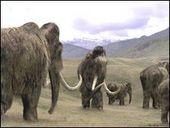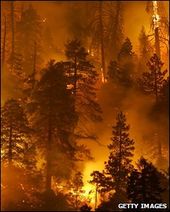
© BBC NewsWoolly mammoths were not the only ones to die out 13,000 years ago.
Analysis of charcoal and pollen records from around 13,000 years ago showed no evidence of continental-scale fires the cometary impact theory suggests.
However, the results showed
increased fires after periods of climate change.
The research is published in the
Proceedings of the National Academy of Sciences.
The cometary impact hypothesis holds that an enormous comet slammed into or exploded over North America in the Younger Dryas period some 12,900 years ago.
The idea was first mooted by Richard Firestone of Lawrence Berkeley Laboratory in the US and colleagues in 2007.
The impact, they argue, would have unleashed a shock wave and ignited fires spanning the entire continent. That in turn would explain a number of other observations.
For instance, the wildfires would have burned all the plant matter in their wake, effecting the evident end of the prehistoric Clovis culture of humans.
The lack of vegetation would also have contributed to the extinction of the "megafauna" - large animals such as woolly mammoths and mastodons - that disappear from the fossil record around that time.
But the theory has inspired a degree of scepticism in the palaeontology community, and many suggest that much more data is needed to prove or refute it.
"The claim of course makes good headlines: 'Cometary impact kills the mammoths', but I'm not sure it's quite like that," said Andrew Scott of Royal Holloway, University of London, a co-author on the new research.
"Even if you have cometary impact data, that doesn't imply they generated wildfires that killed off the mammoths.
"What we've always needed was a way to test the hypothesis. This is the first chance to test it with all the records that we've had across North America."
Professor Scott and the rest of a team including the Global Palaeofire Working Group analysed the well-preserved charcoal and pollen layers beneath lakes and in peat bogs across the continent.
These layers of sediment read like a history book of each region, with thousands of years of climate and wildfire history laid out by depth.
By correlating the ages of different layers from different regions using radioisotope analysis and matching those up with more recent data like that from tree rings, the history book yielded up a number of interesting results.
One of them is that while there was significant evidence of localised fires throughout a 5,000-year period centred around the Younger Dryas, there was no sign of a single, continental-scale wildfire event.
The finding does not refute the possibility of comet strikes in the past, Professor Scott notes, but casts serious doubt on the grand scale wildfires that would have wiped out whole species and cultures.
Moreover, it is not the only thread of evidence that has been called into question in the debate.
Most recently, those involved in the impact theory point to nanometre-scale diamond samples found in a sediment layer corresponding to the time of the impact, but Wallace Broecker of the Lamont-Doherty Earth Observatory (LDEO) at Columbia University points out that such nanodiamonds have been found in modern peat bogs.

© Getty ImagesScenes like this become more common after abrupt climate change.
"One by one, every piece of evidence they [comet hypothesis proponents] have presented is going to fall," Professor Broecker told BBC News.
"But one of the stronger ones was this fire stuff, so this hits right at the heart of their argument."
The problem, Professor Scott says, is that the impact hypothesis has made many people focus on just one page of the sedimentary history book: the layer from 12,900 years ago.
"When you concentrate on one layer so intensely, you find all sorts of things which you think are unique," he added.
Richard Firestone, commenting on the work, does not believe it presents a serious challenge to the impact theory - in fact, he argues that they are in agreement."Their data is too low resolution to say much about what happened 12,900 years ago," he told BBC News.
"The paper merely shows that fires increased near the onset of the Younger Dryas and continued for some time. These results are in complete agreement with what we observed."
Of more importance to current climate watchers is the finding that during the 5,000-year period studies, the greatest incidence of fires occurred just after periods of abrupt climate change.
While the idea that periods of warming would be followed by periods of high fire occurrence is not new, the result is the first evidence-based proof of the connection.
Periods of climate change result in the death of plants and trees that more readily provide fuel.
The recent report in the journal Science of forests in the western US dying faster as temperatures rise is another sign that we may be entering a period of significant wildfire increase.
"One of the issues that concerns me is that there are many parts of the world, like Britain, where there's not naturally a lot of wildfire, so we're not prepared for it," said Professor Scott.
"There's no contingency, no thinking ahead of what might happen;
climate change has significant impact other than just rising sea levels."
Reader Comments
to our Newsletter